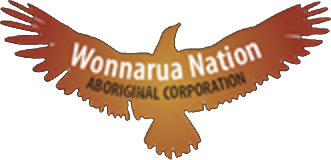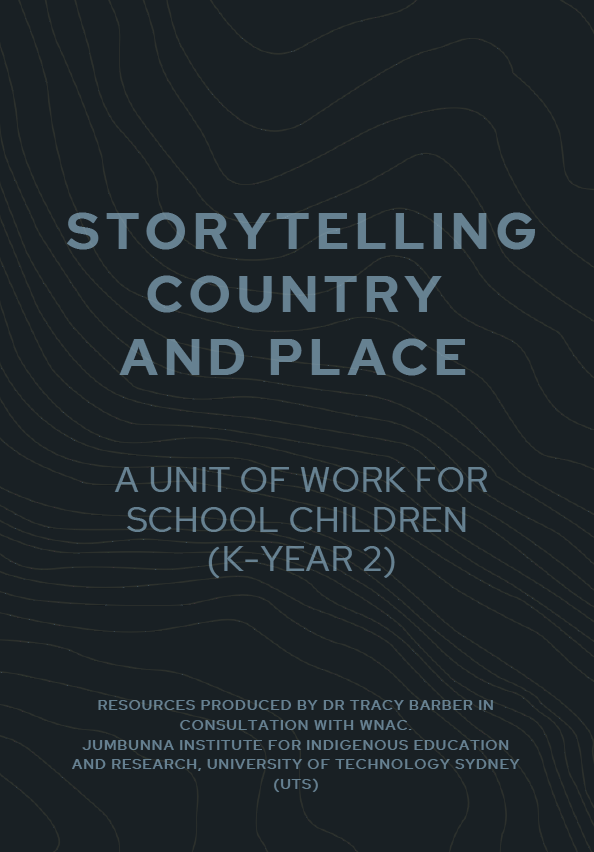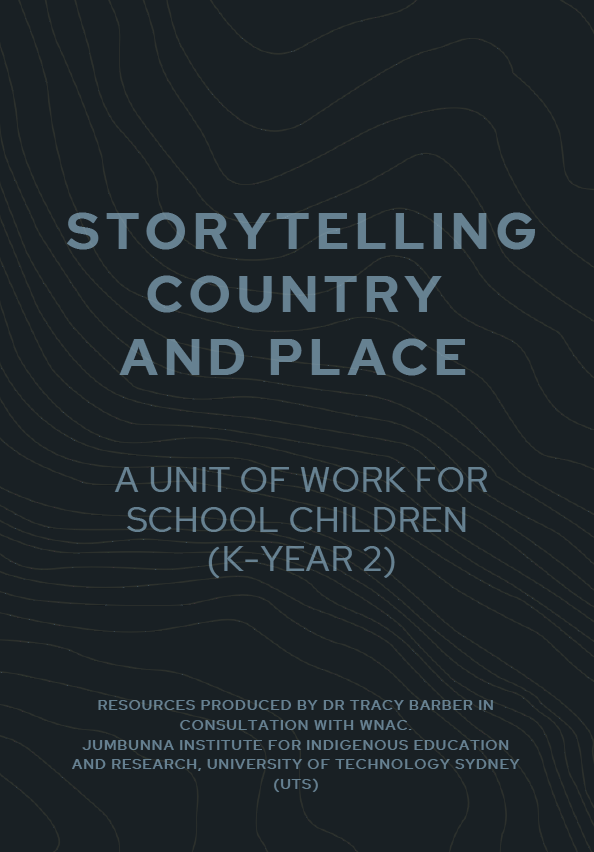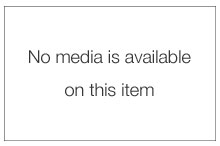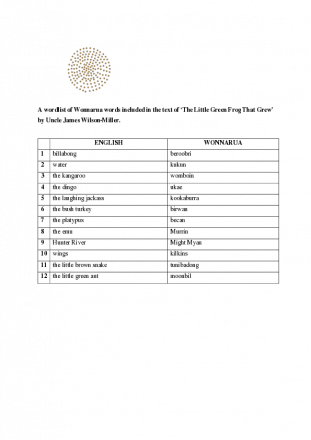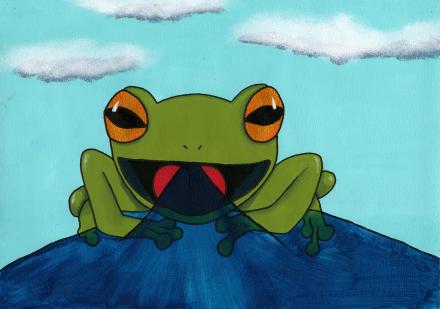Activities for school children (K-Year 2)
Storytelling, Country and Place
A unit of work for school children (K-Year 2)
Resources produced by Dr Tracy Barber in consultation with Wonnarua Aboriginal Corporation (WNAC). Jumbunna Institute for Indigenous Education and Research, University of Technology Sydney (UTS)
Overview
This unit of work contains ideas and activities for K-2 students to stimulate their awareness and engagement with Wonnarua language and culture. It includes a traditional Wonnarua story, and uses this as a stimulus for related creative writing, art and geography activities. All the activities can be adapted to suit your particular circumstances, whether in a school, home or community setting. It was developed in consultation with WNAC by Tracy Barber from the Jumbunna Institute for Indigenous Education and Research, University of Technology Sydney (UTS)
Objectives
The overall objectives of the unit are to:
- Engage students in learning about Wonnarua language and culture through a traditional Wonnarua story
- Develop students’ understanding of the special relationship that Wonnarua people have to Country and Place
- Stimulate students’ awareness of the environmental context of the story, including animals, plants and water sources
- Increase awareness and appreciation amongst non-Indigenous students of Wonnarua culture and language
- Strengthen the links between the school setting and community language revival in the local Aboriginal community.
Duration: 4-5 lessons
Cultural Protocols
These learning resources have been developed in consultation with the Wonnarua Nation Aboriginal Corporation (WNAC) and are aligned with the following guidelines:
- Board of Studies NSW (2003), Aboriginal Languages K-10 Syllabus, Board of Studies NSW, Sydney.
- Board of Studies NSW (2003), Aboriginal Languages: Advice on Programming and Assessment for Stages 4 and 5, Board of Studies NSW, Sydney.
Mukurtu resources used in the unit
- The Tiddalick story by James Wilson Miller
- The Tiddalick word list
- Photo image of the Tiddalick rock formation site
Other resources required
- Images (photos, drawings) of the animals referred to in the Tiddalick story with the Wonnarua word written underneath (created by educator using the Tiddalick word list)
- Students’ books for writing and drawing
- Writing, drawing and painting materials
Activities
1. Storytelling and language
- Sit with the children in a circle, if possible in a natural outdoor setting but if not on the floor in an open indoor space.
- Explain to the group that they are going to hear an old Wonnarua story, and that the Wonnarua are Aboriginal people who have lived in the area for thousands of years. Acknowledge if there are children with Wonnarua heritage in the group.
- Ask students questions to stimulate engagement and interest such as:
* What do you think the story will be about?
* Have you ever read or heard any other Aboriginal stories?
- The group listens to the audio recording of the story or the educator reads the story.
- Follow up by talking about the story, with possible questions including:
* Why was the little frog Tiddalick upset?
* Why do you think the other animals didn’t let him get to the water?
* What else could Tiddalick have done besides drinking all the water?
* How did the animals try to persuade Tiddalick to give back the water?
* What else might the animals have done?
* What was your favourite part of the story?
* Which was your favourite animal? Why?
- Ask the group who can remember any of the Wonnarua names for the animals?
- Prompt by saying one of the names and asking the students if they can remember/guess which animal it is? Show an image of the actual animal with the Wonnarua word underneath, repeat the Wonnarua word aloud and ask the class to repeat it together.
• Ask the students to:
* Choose one of the animals from the story and draw in your book
* Describe your animal and what it did in the Tiddalick story
* Write the Wonnarua word for your animal in your book.
- Display the animal images with Wonnarua words clearly for students to see and refer to.
Resources required for this activity
Mukurtu resources
- The Tiddalick story by James Wilson Miller
Other resources
- Images (photos, drawings) of the animals referred to in the Tiddalick story with the Wonnarua word written underneath
- Students’ books for writing and drawing
2. Learning more about place and Country
Explain that you are going to show the group a picture of the place where Tiddalick is said to have been turned into stone. Show the Tiddalick site photo and talk about it together, asking questions such as:o What can you see in the photo?
What shape is the rock?
* What’s around the rock?
• Explain that the Wonnarua people have lived for thousands of years on this Country and that this is a special place for them. Talk with the group about the ways in which the Wonnarua care for the country.
• Ask the students questions about their own special places such as:
* Do you have a special place? Why is it special to you?
* Does your family have a special place? Where is it and what do you like to do in your special place?
* What about your friends, do they have special places?
* What do you do to care for your special place?
• Ask students to:
* In your book write about your special place. Describe where it is, what it looks like and why it is special. Draw a picture of your special place.
Resources required for this activity
Mukurtu resources
- Photo image of the Tiddalick rock formation site
Other resources
- Students’ books for writing and drawing
3. Imagining story and Country through art work
- Introduce activity by asking the children to think about the Tiddalick story. Pointing to the different animals, ask the children if they can say the Wonnarua word, prompting if necessary.
- Ask students to do a painting of the Tiddalick story, imagining what the billabong and bush around it would have looked like.
- Once finished ask the students to describe their painting (either to the educator or to the whole group).
Resources required for this activity
- Painting materials
4. Consolidating and sharing learnings
Create a display in the room using:
- All of the students’ art work (drawings of Country from Point 2 and paintings from Point 4)
- The animal images with the accompanying Wonnarua word
- The Tiddalick site image.
Assessment/Evaluation
- Over the following days the educator could review children’s recall of the story and Wonnarua words, by referring to images of animals and noting students’ recall and level of engagement.
- Educator observes children’s level of engagement with the activities.
- Educator notes children’s capacity to recall Wonnarua words.
NSW Curriculum links
Aboriginal Languages
1.UL.1: Recognises and responds to words, phrases and simple sentences in Aboriginal languages
1.MLC.1: Recognises the diversity of language systems
1.MBC.2: Identifies cultural practices in Aboriginal communities and relates these to personal experiences
English
ENe-6B: Recognises that there are different kinds of spoken texts with specific language features and shows an emerging awareness of some purposes for spoken language
ENe-8B: Demonstrates emerging skills and knowledge of texts to read and view, and shows developing awareness of purpose, audience and subject matter
History
HT1-4: Demonstrates skills of historical inquiry and communication
Geography
GE1-1: Describes features of places and the connections people have with places
Visual Arts
VAS1.1Makes artworks in a particular way about experiences of real and imaginary things.
The wider learning context
1. Integrate Wonnarua language and culture teaching into other parts of the curriculum by including relevant Wonnarua words and short everyday phrases. For example, develop word lists for other books, other lesson content and display around the classroom.
2. Integrate general awareness and understanding of Wonnarua history, language and culture when introducing words and phrases.
